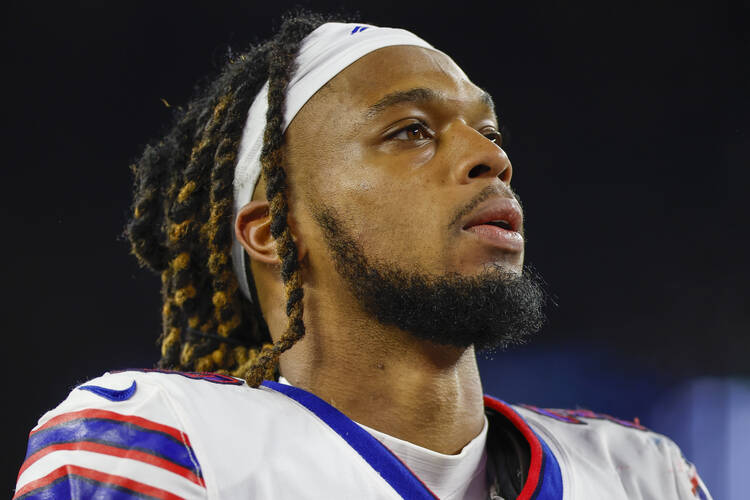You have probably heard Damar Hamlin’s name by now.
If not, Hamlin is a safety for the Buffalo Bills of the National Football League. He collapsed in cardiac arrest during a prime time Monday Night Football game against the Cincinnati Bengals earlier this week. He was administered C.P.R. on the field and rushed by ambulance to the University of Cincinnati Medical Center, where he remains in critical condition.
As you could tell from the reactions from both teams and the broadcast crew, this was not a routine football injury. So much so that the National Football League took the unprecedented step of indefinitely postponing the game (which had major playoff implications, very late in the season) and sending the fans home.
The nation united in prayer: Pull through, kid. I don’t ever remember so many people offering prayers so openly and quickly on sports studio shows. Hamlin’s GoFundMe for toys for kids in need has raised over $6 million from over 200,000 people. ESPN’s broadcast of the game, which is typically myopically focused on X’s and O’s, instead pivoted its coverage to show empathy, sensitivity and hope for a young man’s life.
The nation united in prayer: Pull through, kid. I don’t ever remember so many people offering prayers so openly and quickly on sports studio shows.
“This is about Damar Hamlin,” Ryan Clark, an ESPN analyst and former N.F.L. player, reminded ESPN’s viewing audience. Everyone’s focus should be on his well-being, the consensus seemed to be.
Rightly so. But I have been wondering since Monday if that is really the only place our thoughts and prayers should be focused.
•••
With every horrific mass shooting in the United States, a routine drama plays out in the public discourse about the value of thoughts and prayers. It is a good human impulse to offer prayers for victims and their families, and yet so many find those prayers to be inadequate or even cynical in the face of collective inaction on gun control. “Your thoughts and prayers won’t bring back my loved one,” “Faith without works is dead,” and all that.
It turns out that people do not like to make sweeping changes to their environments and cultures, even in the face of massive suffering. There are more civilian-owned guns than people in the United States. Guns are so intertwined with American life that it’s difficult to really imagine untangling it without massive cultural change.
You know what might be the only thing more deeply embedded in American culture than guns? Football.
You know what might be the only thing more deeply embedded in American culture than guns? Football.
It remains a great unifier in a deeply divided country. Our fandoms are traditions that connect generations. With so many disparate shows and movies to stream, football is the last true water-cooler conversation topic.
I say all of this as someone who loves football and grew up playing it. (I was the meanest third string quarterback Dempsey Middle School has ever seen.) I still watch my Cleveland Browns and Ohio State Buckeyes on weekends. It is a common talking point between so many people in my life, from my grandfather to my barber. I will very likely watch with close interest the N.F.L. playoffs in the coming weeks.
I may try to comfort myself with some talking points: There have been changes to football! After Miami Dolphins quarterback Tua Tagovailoa’s first of two concussions this season, the N.F.L. changed its concussion protocol. Helmet technology continues to improve, and there are new rules about how hard (and where) you can hit a quarterback.
But these minor rule changes all skirt around football’s fundamental problems. No other sport lets 22 players (who are 6 feet 2 inches and 245 pounds on average) run at one another at full speed, with the express purpose of stopping an offensive player by force. Then they get 40 seconds to regain their energy in between every play to go full throttle again, over and over for four hours. Perhaps only boxing has more raw inherent brutality.
Is the circle of our compassion limited by the suffering we see on prime time national television? Because that is the thing—so much of the suffering that football inflicts is hidden from view.
As of now, it remains unclear whether Hamlin’s collapse was explicitly a result of his play on the field.
But the sheer visibility, the images of what happened seems to be what has America reeling: a 24-year-old athlete collapsing, grown men in shoulder pads weeping and embracing, the flashing lights of an ambulance carrying away a mother and son.
“Football changed on Monday night—we won’t know how for years—but we know it changed, because the N.F.L. finally was forced to stop,” Kevin Clark wrote in The Ringer. “None of us wanted to look. This was a night of glazed eyes, thousand-yard stares, and prayer. We hope we never have to see it ever again.”
Is the circle of our compassion limited by the suffering we see on prime time national television? Because that is the thing—so much of the suffering that football inflicts is hidden from view.
Players carry injuries that fans do not know about. Consider Keith McCants, a former first round draft pick. McCants spiraled out of the league after an addiction to painkillers led to more drugs. “I became homicidal and suicidal and couldn’t be trusted,” he told The New York Times. “I didn’t know where I was. I didn’t know about no family or nothing. I didn’t know who Keith McCants was.” He thought that the N.F.L. pushed players to play through pain and injuries. “I will continue to tell the truth, how they got me hooked on drugs,” he said. “I feel it’s my duty as a retired player to explain the difference between being hurt and being injured.” Keith McCants died last year, at the age of 53, in an apparent drug overdose.
That game stopped. But the question remains: Should the rest of them continue?
Then there are the victims of chronic traumatic encephalopathy, which has been found in the brains of more than 320 former N.F.L. players, including at least 24 players who died in their 20s and 30s. C.T.E. has even been linked to a mass shooting, in the case of Philip Adams, a former N.F.L. defensive back who killed six people in April 2021 before dying by suicide. Even though the research on concussions and C.T.E. is in early stages and difficult to study (C.T.E. can only be diagnosed post-mortem), the list is already long enough for many to begin drawing conclusions.
The percentage of American parents worried about their children playing football continues to rise. A study published by the Barrow Neurological Institute found that in 2016, 68 percent of Arizona parents would let their child play football. That number has declined every year, falling to 47 percent in 2020. The parental concern raises the question: If I won’t let my son play this dangerous game, why am I O.K. cheering on someone else’s?
“And so the next time that we get upset at our favorite fantasy player, or we’re upset that the guy on our team doesn’t make the play…we should remember that these guys are putting their lives on the line to live this dream,” Ryan Clark said on SportsCenter on Monday. Maybe it is time to ask whether people should put their lives on the line for a game.
In the immediate aftermath of the injury, broadcaster Joe Buck reported that the N.F.L. wanted to give players a five-minute break before resuming play (the N.F.L. denies this was the case). A national moral consensus emerged: Stop the game. Anything else would be inhuman.
So that game stopped. But the question remains: Should the rest of them continue?








